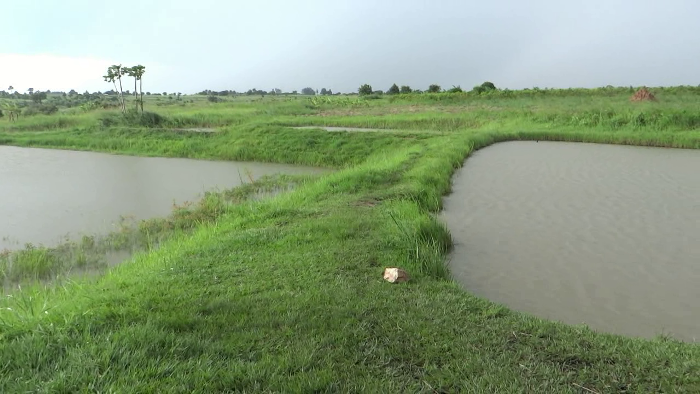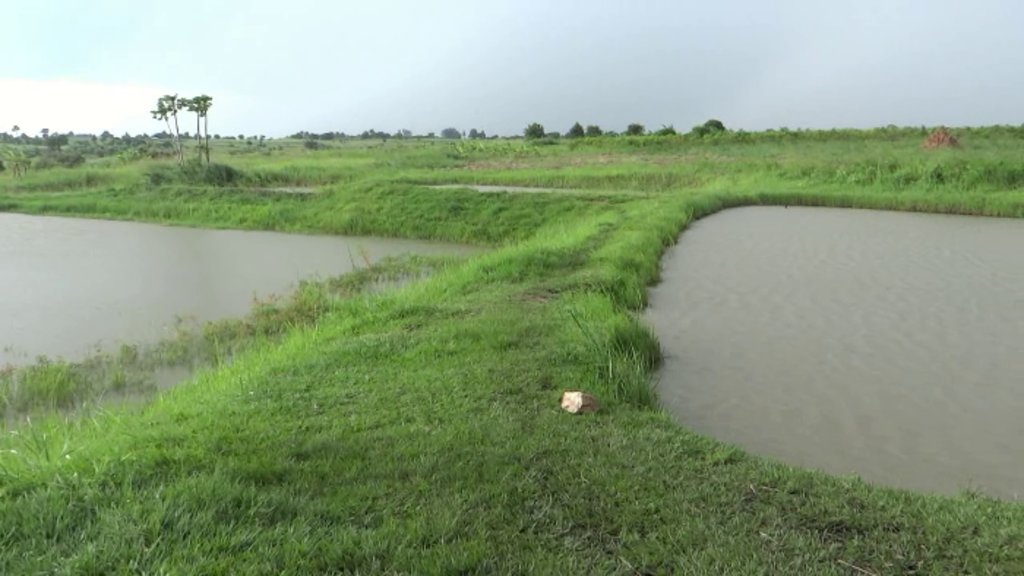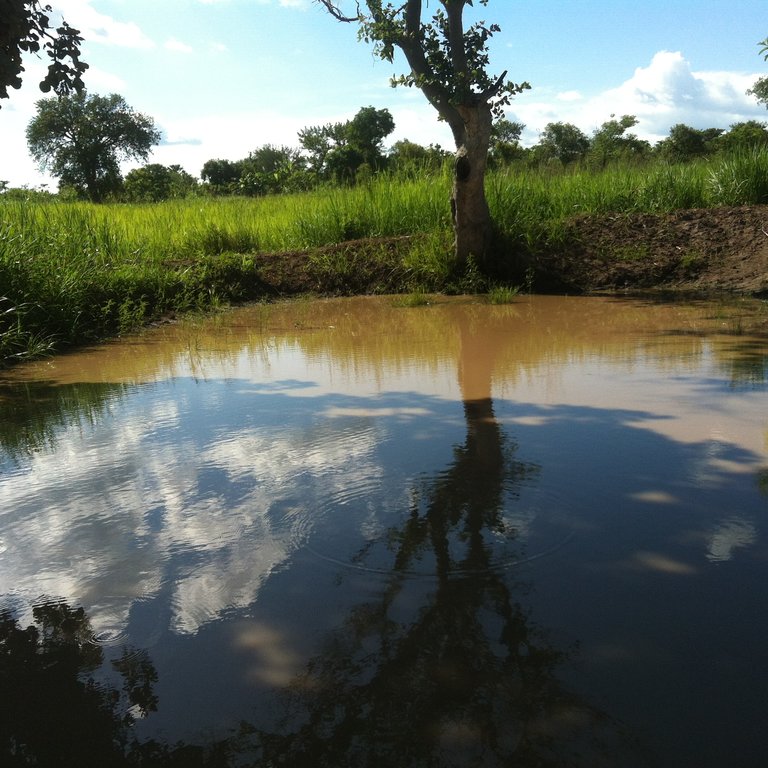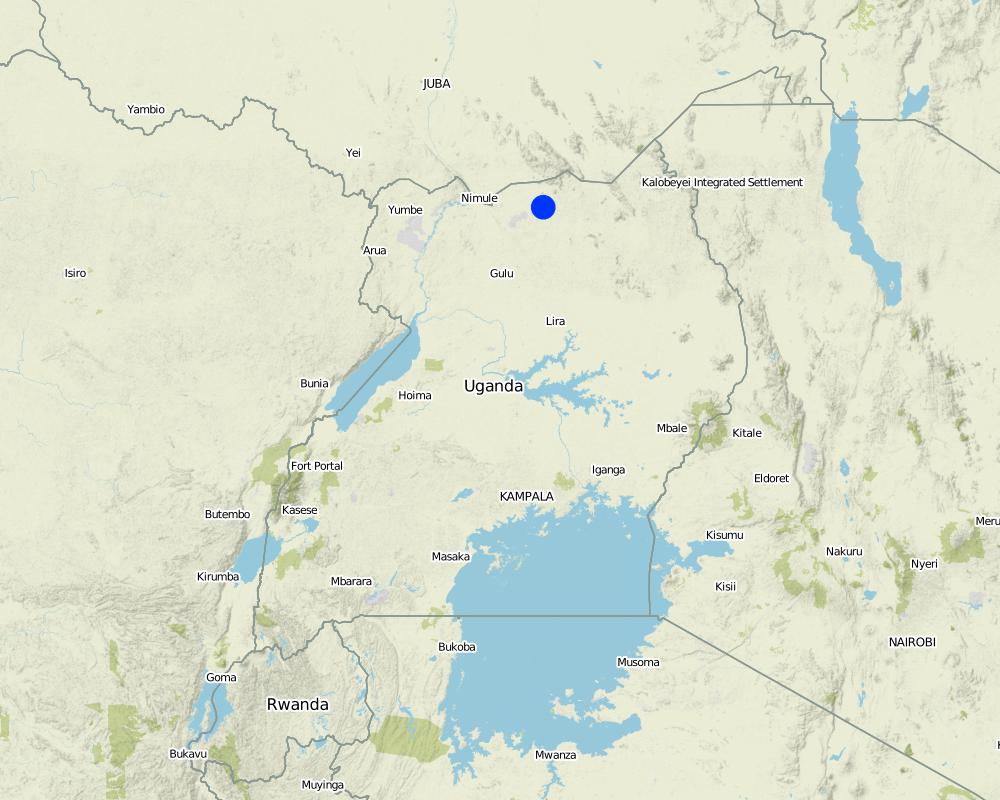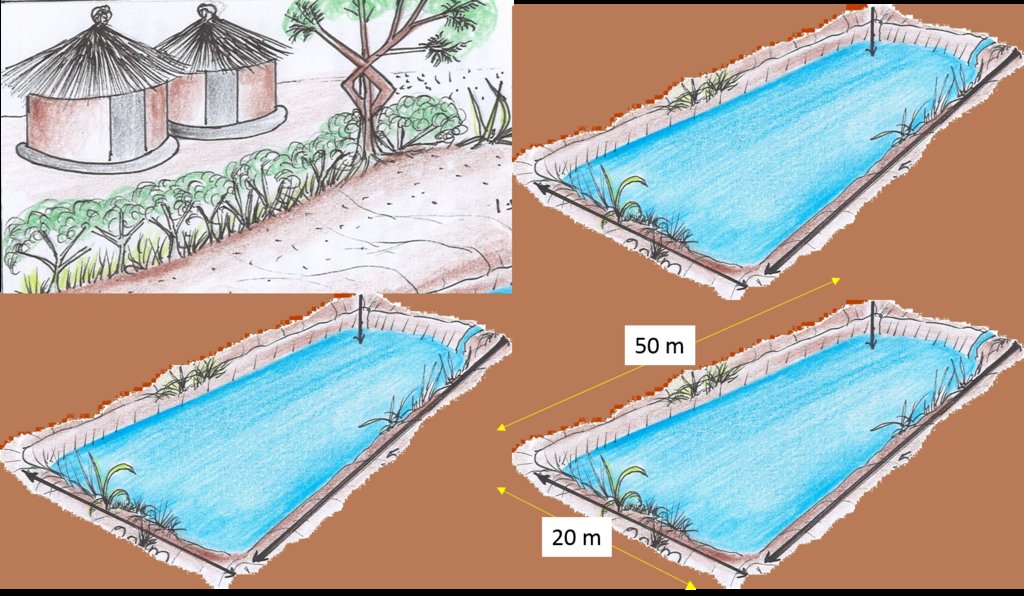Ground water fed fish ponds [乌干达]
- 创建:
- 更新:
- 编制者: Kamugisha Rick Nelson
- 编辑者: JOY TUKAHIRWA, Richard Otto Kawawa, Bernard Fungo
- 审查者: John Stephen Tenywa, Nicole Harari, Renate Fleiner, Stephanie Jaquet, Donia Mühlematter
Pii it Pi Gwooko Rec
technologies_2796 - 乌干达
查看章节
全部展开 全部收起1. 一般信息
1.2 参与该技术评估和文件编制的资源人员和机构的联系方式
关键资源人
土地使用者:
Okot Parikinson
Commercail farmer
Oyam South Village, Lamwo District
乌干达
有助于对技术进行记录/评估的项目名称(如相关)
Scaling-up SLM practices by smallholder farmers (IFAD)有助于对技术进行记录/评估的机构名称(如相关)
CDE Centre for Development and Environment (CDE Centre for Development and Environment) - 瑞士1.3 关于使用通过WOCAT记录的数据的条件
(现场)数据是什么时候汇编的?:
12/05/2017
编制者和关键资源人员接受有关使用通过WOCAT记录数据的条件。:
是
1.4 所述技术的可持续性声明
这里所描述的技术在土地退化方面是否存在问题,导致无法被认为是一种可持续的土地管理技术?:
否
注释:
A high water table is favourable for digging shallow water wells for irrigation of cropland which increases production during the dry season.
2. SLM技术的说明
2.1 技术简介
技术定义:
Fish farming supported by availability of water is considered as profitable enterprise in Northern Uganda. Farmers use areas with either high water tables or swamps to locate the ground water recharged fish ponds and water for fish production and crop irrigation during the dry season.
2.2 技术的详细说明
说明:
Fish farming is a sustainable land management agricultural practice promoted by farmers on medium sized farms in Northern Uganda, where ground water supply in wetland is used to recharge at least three adjacent fish ponds for fish production during the wet and dry season with each pond established measuring 50 m long x 20 m wide and 1.5 m depth with the following inputs hoes, spades, panga, wheel barrow, feeds and labour. The sides of the ponds are grown with grassy vegetation to stabilize soil, as well as feed the fish. It is, therefore imperative that farmers who want to invest in such sustainable land management practice first seek professional advice from extension agents or from other experienced farmers, on post-harvest fish handling and preservation. In Northern Uganda, fish theft and poisoning are also rampant, especially where ponds are not properly guarded or fenced. The most costly aspects of pond fish farming include pond excavation, laboratory testing of water and surrounding soil properties; procurement of fries especially tilapia, fencing and procurement of fish feeds. The average cost of establishing each pond is approximately US$428; while putting fish firies establishment goes for an average of US$ 71 per pond.
It is important to note that at the beginning the capital investments are high; these include paying for construction and buying fish fries to put in the ponds. However, in the long term the benefits exceed the costs. This is because fish farming is a high value enterprise with potential to provide household food, nutrition and income security.
2.3 技术照片
2.4 技术视频
注释、简短说明:
Video on Ground water fish ponds in Lamwo District.
日期:
12/0/2017
位置:
Lamwo District
摄影师的名字:
Issa Aiga
2.5 已应用该技术的、本评估所涵盖的国家/地区/地点
国家:
乌干达
区域/州/省:
Northern Region,Uganda
有关地点的进一步说明:
Lamwo District
注释:
Map showing technology site in Northern Uganda.
Map
×2.6 实施日期
注明实施年份:
2000
如果不知道确切的年份,请说明大概的日期:
- 10-50年前
2.7 技术介绍
详细说明该技术是如何引入的:
- 通过土地使用者的创新
- 通过项目/外部干预
注释(项目类型等):
Received training from the extension agent.
3. SLM技术的分类
3.1 该技术的主要目的
- 改良生产
- 创造有益的经济影响
3.2 应用该技术的当前土地利用类型

农田
- 一年一作
主要农作物(经济作物及粮食作物):
Maize

水道、水体、湿地
- 沼泽、湿地
主要产品/服务:
Fish fingers.
如果由于技术的实施而导致土地用途发生变化,则在技术实施前说明土地利的用途。:
Land was under maize plantation, which was usually planted within one year before the implementation of the technology.
3.3 有关土地利用的更多信息
该技术所应用土地的供水:
- 雨养
每年的生长季节数:
- 2
具体说明:
Harvest twice a year (May and December).
牲畜密度(如相关):
4 cows and 5 goats.
3.4 该技术所属的SLM组
- 地表水管理(泉、河、湖、海)
- 养蜂、养殖业、家禽业、养兔业、养蚕业等
3.5 技术传播
具体说明该技术的分布:
- 适用于特定场所/集中在较小区域
注释:
concentrated in a wetland.
3.6 包含该技术的可持续土地管理措施

农艺措施
- A1:植被和土壤覆盖层
- A2:有机质/土壤肥力

植物措施
- V2:草和多年生草本植物
- V3:植被的清理

结构措施
- S5:大坝、集水斗、水池

管理措施
- M1:改变土地使用类型
注释:
Grasses are allowed to grow to stabilise the levees.
3.7 该技术强调的主要土地退化类型

生物性退化
- Bh:栖息地丧失
- Bp:害虫/疾病增加,捕食者减少

水质恶化
- Hs:地表水良变化
- Hp:地表水水质下降

其它
注释:
Vegetation around the pond stabilize the soils which reduces erosion.
3.8 防止、减少或恢复土地退化
具体数量名该技术与土地退化有关的目标:
- 修复/恢复严重退化的土地
注释:
Due to vegetation growth around the fish ponds.
4. 技术规范、实施活动、投入和成本
4.1 该技术的技术图纸
4.2 技术规范/技术图纸说明
Using 6 people paid on daily basis the farmer digs a three adjacent fish ponds either in a wetland on an average land size of less than 0.5 acres each water fed fish pond measuring 50 m long x 20 m wide dug to a depth of not more than 1.5 m. to allow water passively replenishes the pond, The Species kept are Nile perch, tilapia and wild fish.
4.3 有关投入和成本计算的一般信息
具体说明成本和投入是如何计算的:
- 每个技术区域
注明尺寸和面积单位:
0.5 acres
其它/国家货币(具体说明):
UGX
注明美元与当地货币的汇率(如相关):1美元=:
3500.0
注明雇用劳工的每日平均工资成本:
5000 per person per day
4.4 技术建立活动
| 活动 | 措施类型 | 时间 | |
|---|---|---|---|
| 1. | Excavation of soil for ponds | 植物性的 | During the dry season |
| 2. | Soil testing | 农业学的 | During the dry season |
| 3. | Water testing | 农业学的 | Routine, dry and wet season |
| 4. | Buying fries | 其它措施 | Dry and wet season |
| 5. | Stocking the fish | 农业学的 | Wet season and dry season |
| 6. | Feeding | 其它措施 | Dry and wet season |
| 7. | Planting around the pond | 其它措施 | Dry and wet season |
注释:
Planted vegetation can also be used as feed supplement.
4.5 技术建立所需要的费用和投入
| 对投入进行具体说明 | 单位 | 数量 | 单位成本 | 每项投入的总成本 | 土地使用者承担的成本% | |
|---|---|---|---|---|---|---|
| 劳动力 | Monthly persons days | persons | 6.0 | 150000.0 | 900000.0 | 1000.0 |
| 设备 | Hoes | pieces | 6.0 | 10000.0 | 60000.0 | 100.0 |
| 设备 | Spade | peices | 3.0 | 10000.0 | 30000.0 | 100.0 |
| 设备 | panga | pieces | 3.0 | 10000.0 | 30000.0 | 100.0 |
| 设备 | Wheel barrow | piece | 2.0 | 250000.0 | 500000.0 | |
| 其它 | Fish fries for 3 ponds | fries | 3000.0 | 1000.0 | 3000000.0 | 100.0 |
| 其它 | Soil tests | 1 | 2.0 | 350000.0 | 700000.0 | 1000.0 |
| 其它 | water tests | 1 | 2.0 | 380000.0 | 760000.0 | 100.0 |
| 技术建立所需总成本 | 5980000.0 | |||||
注释:
Soil and water tests are done twice before establishment and once after establishment.
4.6 维护/经常性活动
| 活动 | 措施类型 | 时间/频率 | |
|---|---|---|---|
| 1. | Slashing | 管理 | twice a year |
| 2. | Feeding | 管理 | Routine |
4.7 维护/经常性活动所需要的费用和投入(每年)
| 对投入进行具体说明 | 单位 | 数量 | 单位成本 | 每项投入的总成本 | 土地使用者承担的成本% | |
|---|---|---|---|---|---|---|
| 劳动力 | Persons days for feeding and slashing/ monthly | Persons | 1.0 | 150000.0 | 150000.0 | 100.0 |
| 其它 | Feeds monthly | Kilograms | 15.0 | 4000.0 | 60000.0 | |
| 技术维护所需总成本 | 210000.0 | |||||
注释:
Low costs for paying labour due to reduced workload.
Also equipment like hoe , spade, panga are purchased at the time of establishment so no need to incur more costs. Additional costs are incurred when they wear out. At the time of the interview, the land user had not incurred costs on buying tools for maintaining the technology.
4.8 影响成本的最重要因素
描述影响成本的最决定性因素:
Labour for establishing and maintaining the pond.
5. 自然和人文环境
5.1 气候
年降雨量
- < 250毫米
- 251-500毫米
- 501-750毫米
- 751-1,000毫米
- 1,001-1,500毫米
- 1,501-2,000毫米
- 2,001-3,000毫米
- 3,001-4,000毫米
- > 4,000毫米
指定年平均降雨量(若已知),单位为mm:
1250.00
有关降雨的规范/注释:
Two rainy season and two dry season- Bi modal.
农业气候带
- 潮湿的
5.2 地形
平均坡度:
- 水平(0-2%)
- 缓降(3-5%)
- 平缓(6-10%)
- 滚坡(11-15%)
- 崎岖(16-30%)
- 陡峭(31-60%)
- 非常陡峭(>60%)
地形:
- 高原/平原
- 山脊
- 山坡
- 山地斜坡
- 麓坡
- 谷底
垂直分布带:
- 0-100 m a.s.l.
- 101-500 m a.s.l.
- 501-1,000 m a.s.l.
- 1,001-1,500 m a.s.l.
- 1,501-2,000 m a.s.l.
- 2,001-2,500 m a.s.l.
- 2,501-3,000 m a.s.l.
- 3,001-4,000 m a.s.l.
- > 4,000 m a.s.l.
说明该技术是否专门应用于:
- 凹陷情况
关于地形的注释和进一步规范:
Situated in the wetland.
5.3 土壤
平均土层深度:
- 非常浅(0-20厘米)
- 浅(21-50厘米)
- 中等深度(51-80厘米)
- 深(81-120厘米)
- 非常深(> 120厘米)
土壤质地(表土):
- 中粒(壤土、粉土)
土壤质地(地表以下> 20厘米):
- 中粒(壤土、粉土)
表土有机质:
- 中(1-3%)
5.4 水资源可用性和质量
地下水位表:
< 5米
地表水的可用性:
好
水质(未处理):
良好饮用水
水的盐度有问题吗?:
否
该区域正在发生洪水吗?:
否
关于水质和水量的注释和进一步规范:
The farmer has put a drainage system and the levees long enough.
5.5 生物多样性
物种多样性:
- 中等
栖息地多样性:
- 中等
5.6 应用该技术的土地使用者的特征
定栖或游牧:
- 定栖的
生产系统的市场定位:
- 混合(生计/商业
非农收入:
- 低于全部收入的10%
相对财富水平:
- 贫瘠
个人或集体:
- 团体/社区
机械化水平:
- 手工作业
性别:
- 女人
- 男人
土地使用者的年龄:
- 青年人
- 中年人
5.7 应用该技术的土地使用者拥有或租用的平均土地面积
- < 0.5 公顷
- 0.5-1 公顷
- 1-2 公顷
- 2-5公顷
- 5-15公顷
- 15-50公顷
- 50-100公顷
- 100-500公顷
- 500-1,000公顷
- 1,000-10,000公顷
- > 10,000公顷
这被认为是小规模、中规模还是大规模的(参照当地实际情况)?:
- 中等规模的
5.8 土地所有权、土地使用权和水使用权
土地所有权:
- 社区/村庄
- 个人,未命名
土地使用权:
- 社区(有组织)
- 个人
用水权:
- 社区(有组织)
- 个人
注释:
The technology on a communal land owned by the family.
5.9 进入服务和基础设施的通道
健康:
- 贫瘠
- 适度的
- 好
教育:
- 贫瘠
- 适度的
- 好
技术援助:
- 贫瘠
- 适度的
- 好
就业(例如非农):
- 贫瘠
- 适度的
- 好
市场:
- 贫瘠
- 适度的
- 好
能源:
- 贫瘠
- 适度的
- 好
道路和交通:
- 贫瘠
- 适度的
- 好
饮用水和卫生设施:
- 贫瘠
- 适度的
- 好
金融服务:
- 贫瘠
- 适度的
- 好
6. 影响和结论性说明
6.1 该技术的现场影响
社会经济效应
生产
生产故障风险
注释/具体说明:
Well managed with constant feeding.
产品多样性
注释/具体说明:
Promoting different fish fries on the fish ponds.
生产区域
SLM之前的数量:
0
SLM之后的数量:
3
注释/具体说明:
Started with one fish pond and increased to three adjacent fish ponds.
土地管理
注释/具体说明:
Vegetation planted/ allowed to grow around the ponds to act as fodder and stabilizer
水资源可用性和质量
灌溉用水需求
注释/具体说明:
for fish production.
收入和成本
农业投入费用
注释/具体说明:
Purchase of feeds.
农业收入
注释/具体说明:
High due to sale of fish.
收入来源的多样性
注释/具体说明:
Sale of fish.
经济差异
注释/具体说明:
Between those who have fish ponds and those who don't have.
工作量
注释/具体说明:
Increased workload at establishment for digging ponds, feeding the fish fries compared to maintenance.
社会文化影响
食品安全/自给自足
注释/具体说明:
Relies on fish from the pond.
娱乐机会
注释/具体说明:
Other farmers coming to learn from the technology.
SLM/土地退化知识
注释/具体说明:
Training by the extension worker on feeding and management.
生态影响
水循环/径流
水量
注释/具体说明:
Water re-charged from underground.
水的回收/收集
注释/具体说明:
Underground harvesting and kept in the pond for fish production during the dry season.
生物多样性:植被、动物
植被覆盖
注释/具体说明:
Vegetation allowed to grow on the ponds as stabilizer and feeds.
有益物种
注释/具体说明:
More fish fries varieties stocked by the farmer in the ponds :3 different species.
害虫/疾病控制
注释/具体说明:
Training by the extension agent on how to control.
减少气候和灾害风险
干旱影响
注释/具体说明:
under ground water harvesting water to be favour fish survival during the dry season.
火灾风险
注释/具体说明:
located in the wetland.
6.2 该技术的场外影响已经显现
水资源可用性
注释/具体说明:
re-charged from under ground,
6.3 技术对渐变气候以及与气候相关的极端情况/灾害的暴露和敏感性(土地使用者认为的极端情况/灾害)
渐变气候
渐变气候
| 季节 | 气候变化/极端天气的类型 | 该技术是如何应对的? | |
|---|---|---|---|
| 年温度 | 减少 | 好 | |
| 季节性温度 | 湿季/雨季 | 减少 | 好 |
| 年降雨量 | 减少 | 好 | |
| 季雨量 | 湿季/雨季 | 减少 | 适度 |
气候有关的极端情况(灾害)
气候灾害
| 该技术是如何应对的? | |
|---|---|
| 干旱 | 非常好 |
| 陆地火灾 | 好 |
生物灾害
| 该技术是如何应对的? | |
|---|---|
| 流行病 | 适度 |
6.4 成本效益分析
技术收益与技术建立成本相比如何(从土地使用者的角度看)?
短期回报:
轻度消极
长期回报:
积极
技术收益与技术维护成本/经常性成本相比如何(从土地使用者的角度看)?
短期回报:
稍微积极
长期回报:
稍微积极
注释:
slightly negative at the time of establishment with purchase of labour, purchase of fish fries and lab testing but positive when workload reduces and its associated costs with the farmer harvesting and selling fish for income.
6.5 技术采用
- 1-10%
如若可行,进行量化(住户数量和/或覆盖面积):
Mostly those with some capital
在所有采用这项技术的人当中,有多少人是自发地采用该技术,即未获得任何物质奖励/付款?:
- 10-50%
注释:
More farmers were trained by National Agricultural Advisory services (NAADS) and Open Wealth Creation (OWC), acquired knowledge and skills and started on their own without material incentives.
6.6 适应
最近是否对该技术进行了修改以适应不断变化的条件?:
否
6.7 该技术的优点/长处/机会
| 土地使用者眼中的长处/优势/机会 |
|---|
| Provides high benefits (income) in the short run. |
| Its replicable elsewhere by both small scale and large scale land users. |
| Uses recharged from under ground which is available all year round. |
| 编制者或其他关键资源人员认为的长处/优势/机会 |
|---|
| Good and sustainable technology. Does not require constant labour once its established. Low costs of labour required for routine and maintenance activities. |
| Can survive on planted vegetation to supplement fish feeds. |
6.8 技术的弱点/缺点/风险及其克服方法
| 土地使用者认为的弱点/缺点/风险 | 如何克服它们? |
|---|---|
| Requires high level sophisticated skills in water and soil testing / high costs. | Testing using local indicators. |
| Not fenced. Possibility of poisong the fish. | Fencing the fish pond and if possible employ a local secuirty guard. |
| 编制者或其他关键资源人员认为的弱点/缺点/风险 | 如何克服它们? |
|---|---|
| Labour and capital intentive at the time of establishment/ Appropriate to the rich. | Link farmers to Agricultural loans and pay after selling fish. |
7. 参考和链接
7.1 信息的方法/来源
- 实地考察、实地调查
01
- 与土地使用者的访谈
01
链接和模块
全部展开 全部收起链接
无链接
模块
无模块


